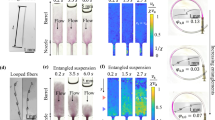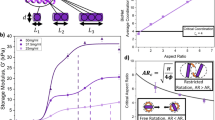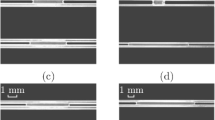Abstract
In this work, we consider wetting and flow of oligomer binders for tissue fibers made of carbon and organic fibers. A correlation between the specific surface of fibers and strength of the boundary layers is established. The effect of fibers on structure formation of binders in the boundary layers is explained via the surface density of reticulation of fiber. The fibers with minimum surface reticulation exert a pronounced influence on the structure of binders, forming thicker and strong boundary layers.
Similar content being viewed by others
References
A. S. Borodulin, G. V. Malysheva, and I. K. Romanova, “Optimization of rheological properties of binders used in vacuum assisted resin transfer molding of fiberglass,” Polym. Sci., Ser. D 8 (4), 300–303 (2015).
G. V. Malysheva, E. S. Ahmetova, and A. N. Marycheva, “Estimation of glass transition temperature of polysulfone modified epoxy binders,” Glass Phys. Chem. 40 (5), 543–548 (2014).
G. V. Malysheva, E. Sh. Akhmetova, and Yu. Yu. Shimina, “Determination of phase transition temperatures of polymer binding agents by differential scanning calorimetry,” Polym. Sci., Ser. D 8 (1), 17–21 (2015).
G. V. Malysheva and I. R. Saifulin, “Methods for evaluating the content of the polymer matrix in the composite material,” Vse Mater., Entsikl. Sprav., No. 1, 2–5 (2014).
N. I. Baurova, V. A. Zorin, and V. M. Prikhod’ko, “Description of the process of degradation of material properties using the apparatus of catastrophe theory,” Polym. Sci., Ser. 8 (2), 92–95 (2015).
O. Yu. Bur’yan and V. U. Novikov, “Modeling of the interfacial layer in composites with polymeric matrix. Determination of its structure and mechanical properties,” Mekh. Kompoz. Mater. 38 (3), 289–304 (2002).
V. U. Novikov and R. A. Tkalenko, “Simulation of composites with parameterization on graphs,” Mekh. Kompoz. Mater. 61 (4), 650–660 (1996).
P. A. Belov and V. A. Nelyub, “The theory of media with conserved dislocations: A unified nature of the adhesive and costal interactions,” Klei, Germetiki, Tekhnol., No. 5, 28–34 (2013).
V. A. Nelyub and P. A. Belov, “Methods for increasing the resistance of CFRP to delamination by controlling the fiber adhesion to the matrix,” Nov. Materialoved., Nauka Tekh., No. 7 (19), 28 (2013).
V. A. Nelyub, “Characteristics of interfacial layers of polymer composite materials,” Polym. Sci., Ser. D 7 (4), 310–312 (2014).
V. B. Litvinov, et al., “Structural and mechanical properties of high-strength carbon fibers,” Kompoz. Nanostrukt., No. 3, 36–50 (2011).
V. A. Nelyub, A. M. Gus’kov, and P. A. Belov, “On designing of CFRPs for tensile strength taking into account fiber adhesion to the matrix,” Aktual. Probl. Gum. Estestv. Nauk, No. 12, 62–66 (2014).
Yu. G. Frolov, Textbook of Colloid Chemistry: Surface Phenomena and Disperse Systems (Khimiya, Moscow, 1989).
L. P. Kobets, “Kinetics of impregnation of carbon and aramid fibers by liquids,” Plast. Massy, No. 9, 18–24 (2007).
V. A. Nelyub, “Method for assessing the chemical reaction between carbon fibre and epoxide binder,” Fibre Chem. 47 (1), 40–42 (2015).
Author information
Authors and Affiliations
Corresponding author
Additional information
Original Russian Text © V.A. Nelyub, A.S. Borodulin, L.P. Kobets, G.V. Malysheva, 2016, published in Vse Materialy. Entsiklopedicheskii Spravochnik, 2016, No. 3, pp. 43–48.
Rights and permissions
About this article
Cite this article
Nelyub, V.A., Borodulin, A.S., Kobets, L.P. et al. Capillary hydrodynamics of oligomer binders. Polym. Sci. Ser. D 9, 322–325 (2016). https://doi.org/10.1134/S1995421216030199
Received:
Published:
Issue Date:
DOI: https://doi.org/10.1134/S1995421216030199




